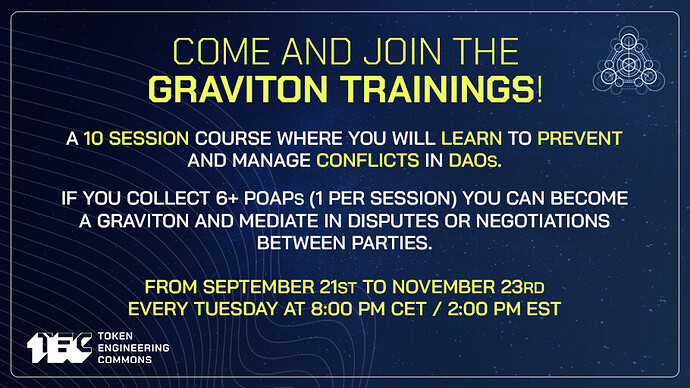FIRST GRAVITON TRAINING.
Starting: 21st January, ending 11th March.
For 8 sessions of 1h or 1h30min, total of 12 hours. (1 session per week) Thursdays 9:00 pm CET - After TEC community call
The graviton is the hypothetical quantum of gravity, an elementary particle that mediates the force of gravity.
This short course aims to make people in the TEC understand the cultural principles to reproduce in the community and provide capacitation around non violent communication, understanding of conflicts and techniques to manage it (internally, individually and collectively), with the purpose of promoting trust into our shared rules and boundaries.
Gravitons shall be able to
-
Make an effort to be present and accessible to the community, bringing high vibes and improving relationships, bringing the community together.
-
Separate the people from problems. Making parties identify with themselves and the other as equals, rather than centering on their own conflictive thoughts-feelings.
-
Self-determinate from all parties and recognize key management points by analyzing the information gathered.
-
Promote empathy between conflicting parties with emotional intelligence. Building proximity from the abstraction of the problem and the humanization of apparent antithesis.
-
Adapt their mindset for tolerance to conflictive situations, keeping calm and diplomacy to stand as an independent third party.
-
Propose alternatives to deal with paradoxes while looking for the coexistence and attraction of opposites.
-
Act according to institutional regulations while implementing actions to frame unwanted behavior within rules and boundaries (Terms & conditions / Codes of conduct / Graduated sanctions)
Plan of study:
Weekly pattern:
- Gravitons read the resources presented
- Gravitons attend the Class
- Gravitons answer the Questions to receive the POAP
- Resources to read for the next week are promoted
Session 1: Suggested coach - Regis Chapman (21th January)
“Trust creation”, Nonviolent communication & Spiral dynamics
a) NVC Summary (M. Rosenberg): https://srinathramakrishnan.files.wordpress.com/2016/07/non-violent-communication-summary.pdf
b) (video) Oren Jay Sofer. Say What You Mean: A Mindful Approach to Nonviolent Communication Say What You Mean: A Mindful Approach to Nonviolent Communication - YouTube
c) Using Spiral Dynamics to understand development https://medium.com/@jthowlett/using-spiral-dynamics-to-understand-development-930098e8f092
d) Integral Dynamics, A new integration of Wilber’s Integral Theory and Spiral Dynamics http://www.ijhssnet.com/journals/Vol_6_No_6_June_2016/10.pdf
e) (video) My stroke of insight - Jill Bolte Taylor https://www.youtube.com/watch?v=UyyjU8fzEYU&feature=emb_logo
Questions:
- How does NVC help to build trust and prevent conflicts?
- What is Spiral Dynamics and how does it understand development?
- What is the difference between separated and unified thinking?
Session 2: Suggested Coach - Juan Bell (28th January)
Theories of conflict, Antifragility and Conflict Management
-
J. Paul Lederach, little book of conflict transformation https://professorbellreadings.files.wordpress.com/2017/10/the-little-books-of-justice-peacebuilding-john-lederach-the-little-book-of-conflict-transformation-good-books-2014-1.pdf
-
Lederach Summary: http://peacebuildingforlanguagelearners.pbworks.com/w/file/fetch/73426925/Lederach%20
-
Taleb, Antifragile. Things that gain from disorder https://drive.google.com/file/d/1KiuG5ye52VikNqPPBCvm2D0AxvcJBNrm/view?usp=sharing
-
(Video) Antifragile https://www.youtube.com/watch?v=S3REdLZ8Xis
-
Conflict management and peacebuilding in everyday life https://www.reddbarna.no/Media/dokumenter/ResourceKit-web.pdf
-
Galtung, Conflict transformation by peaceful means https://www.issuelab.org/resources/19719/19719.pdf
-
(Español) Qué son los conflictos https://drive.google.com/file/d/1ovWrJw3w6t-opZQyB_fys71WbZnZ7we4/view?usp=sharing
Questions:
- What is a conflict transformation platform according to J. P. Lederach?
- What are the key points of the transcend method as proposed by J. Galtung?
- What is the property of antifragility according to N. Taleb
Session 3: BATNA, Negotiations & Alternative Dispute Resolution mechanisms Suggested Coach: Juan Bell (4th February)
a) The future of ADR in 2020 https://www.imimediation.org/wp-content/uploads/2017/09/the-future-of-adr-in-2020-article.pdf
b) What is a BATNA?: https://drive.google.com/file/d/1ZHMyDW-RDgCDc6tkJjOqBdJ096RRerqq/view?usp=sharing
c) Five ways to keep disputes out of court https://hbr.org/1990/01/five-ways-to-keep-disputes-out-of-court
d) Rahman, Mediation and mediator skills: a critical appraisal https://www.researchgate.net/publication/316918509_Mediation_and_Mediator_Skills_A_Critical_Appraisal
e) Justice circles: https://oscr.umich.edu/article/restorative-justice-circles
f) (video) W. Ury, https://youtu.be/-2lcXp-MiVQ?t=749
g) (Español) Sistemas alternativos de resolución de conflictos: negociación, conciliación, mediación, arbitraje, en el ámbito civil y mercantil https://dialnet.unirioja.es/descarga/articulo/4182033.pdf
Questions:
- What is the difference between BATNA, negotiation, mediation, conciliation & arbitrage
- What are the main steps of a mediation process, what are some the ethical standards of a mediator?
- What does the formula “Balcony, Bridge, Third Part” mean?
Session 4: Practical cases (individual conflicts) Feb 11th
a) Understanding the impact of role plays & simulations for conflict management https://drive.google.com/file/d/1SNiGTwJFb_z4XL4K3Ice5Atnyg68Izjp/view?usp=sharing
b) How exercises, cases and coaching can make you a better negotiator https://drive.google.com/file/d/1X5lvtT3ha-wvq-JVlfUJJmRn0EZQUrdE/view?usp=sharing
c) Make the most of online negotiations https://drive.google.com/drive/u/0/folders/1g2rMoMJWcQ-yBH9Qj1yOc937KsvD99VS
Session 5: Suggested Coach: Livia Deschermayer (Feb 18)
Soft Governance & Culture: Ostrom’s principles for enduring CPR Institutions
a) TEC Cultural build: soft Gov miro board
b) Rebuilding Companies as Communities Rebuilding Companies as Communities
c) Ostrom, Governing the Commons https://wtf.tw/ref/ostrom_1990.pdf
d) Ostrom Summary https://drive.google.com/file/d/1nLeB-Rmchee9zsyyNCnJdBlgqYulbH1-/view?usp=sharing
e) (Español) Ostrom Resumen https://drive.google.com/file/d/1C3XXakFQCKYCaxd8SXeJJJ3Z1IsPLqfX/view?usp=sharing
Questions:
- What is the importance of having a strong cultural build in DAOs
- What are the similarities between CPRs and DAOs
- What are some of the principles for enduring CPR institutions, according to E. Ostrom
Session 6: TEC Code of conduct, participation in community management & benefits / requirements for gravitons. (Feb 25)
Gravitons participation in Community management → focus in this last two sessions is to understand that the purpose of gravity (and gravitons) is to bring us together.
-
TEC Code of Conduct TEC CODE OF CONDUCT - Google Docs
-
Gravity Forum Posts
(I) Role design https://forum.tecommons.org/t/gravity-role-design/174
(II) General process https://forum.tecommons.org/t/gravity-general-process/173
(III) Onboarding https://forum.tecommons.org/t/gravity-onboarding/175
- Mechanisms to request Gravity conflict management
· Typeform https://the-commons-stack.typeform.com/to/rCVsK5RK
· & Calendly https://calendly.com/bell-juan-carlos/15min availability.
- Gravity group registry spreadsheet https://docs.google.com/spreadsheets/d/1HH1lhY4HScQzE1f7cjk89lkoMu3Uw3vmPbFsu97jZa4/edit#gid=0
Session 7: Gravity process deep dive (forms, graduated sanctions) (MARCH 4)
a) Gravity initial document https://docs.google.com/document/d/19tpH6EU8jYX4FQ0CBtUf0MdsLzjpVo5x7n9W38u9Us4/edit?usp=sharing
b) Graduated sanctions → Soft Gov Miro board https://miro.com/welcomeonboard/WynOwXI4AgjZbN6wVRdUGfc6loa2lqEaYL4VMEg2ZBaqsiJD8T5lrkbw7Eq47bCz
c) Gravity Wg call notes https://docs.google.com/document/d/19tpH6EU8jYX4FQ0CBtUf0MdsLzjpVo5x7n9W38u9Us4/edit
d) Forms for conciliation process/agreement - Apendix E : from page 88/131
Session 8: Practice case (group conflicts) (MARCH 11)
Collective role play
 , durgadas, dexVicente, dan.curates
, durgadas, dexVicente, dan.curates


